Ethical Considerations in Managing Resistance to Organizational Change
VerifiedAdded on 2020/04/07
|9
|2997
|440
Essay
AI Summary
The essay evaluates how employees resist organizational change due to fear and uncertainty, similar to managers who leverage power structures to influence change. The discussion highlights that ethical management is crucial in mitigating resistance and ensuring successful change implementation. It emphasizes Kurt Lewin’s model as a tool for facilitating learning processes during change, thus ethically aligning employee acceptance with organizational goals. By reframing resistance positively, organizations can refine their change strategies, enhancing efficiency and stability against external pressures. Through this analysis, the essay underscores the importance of ethical considerations in managing resistance to foster sustainable organizational development.

Resistance to change in an organisation
Paraphrase This Document
Need a fresh take? Get an instant paraphrase of this document with our AI Paraphraser
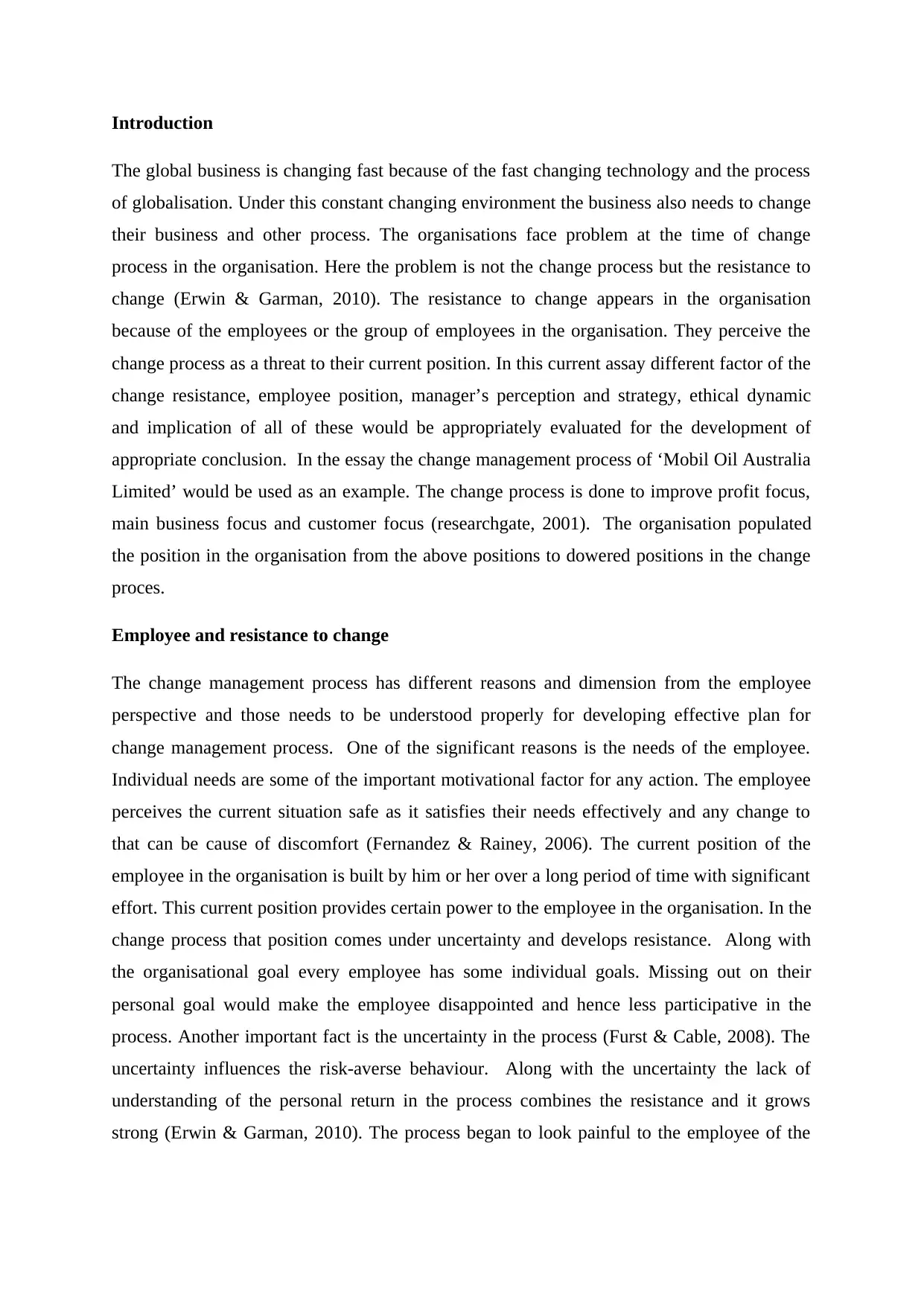
Introduction
The global business is changing fast because of the fast changing technology and the process
of globalisation. Under this constant changing environment the business also needs to change
their business and other process. The organisations face problem at the time of change
process in the organisation. Here the problem is not the change process but the resistance to
change (Erwin & Garman, 2010). The resistance to change appears in the organisation
because of the employees or the group of employees in the organisation. They perceive the
change process as a threat to their current position. In this current assay different factor of the
change resistance, employee position, manager’s perception and strategy, ethical dynamic
and implication of all of these would be appropriately evaluated for the development of
appropriate conclusion. In the essay the change management process of ‘Mobil Oil Australia
Limited’ would be used as an example. The change process is done to improve profit focus,
main business focus and customer focus (researchgate, 2001). The organisation populated
the position in the organisation from the above positions to dowered positions in the change
proces.
Employee and resistance to change
The change management process has different reasons and dimension from the employee
perspective and those needs to be understood properly for developing effective plan for
change management process. One of the significant reasons is the needs of the employee.
Individual needs are some of the important motivational factor for any action. The employee
perceives the current situation safe as it satisfies their needs effectively and any change to
that can be cause of discomfort (Fernandez & Rainey, 2006). The current position of the
employee in the organisation is built by him or her over a long period of time with significant
effort. This current position provides certain power to the employee in the organisation. In the
change process that position comes under uncertainty and develops resistance. Along with
the organisational goal every employee has some individual goals. Missing out on their
personal goal would make the employee disappointed and hence less participative in the
process. Another important fact is the uncertainty in the process (Furst & Cable, 2008). The
uncertainty influences the risk-averse behaviour. Along with the uncertainty the lack of
understanding of the personal return in the process combines the resistance and it grows
strong (Erwin & Garman, 2010). The process began to look painful to the employee of the
The global business is changing fast because of the fast changing technology and the process
of globalisation. Under this constant changing environment the business also needs to change
their business and other process. The organisations face problem at the time of change
process in the organisation. Here the problem is not the change process but the resistance to
change (Erwin & Garman, 2010). The resistance to change appears in the organisation
because of the employees or the group of employees in the organisation. They perceive the
change process as a threat to their current position. In this current assay different factor of the
change resistance, employee position, manager’s perception and strategy, ethical dynamic
and implication of all of these would be appropriately evaluated for the development of
appropriate conclusion. In the essay the change management process of ‘Mobil Oil Australia
Limited’ would be used as an example. The change process is done to improve profit focus,
main business focus and customer focus (researchgate, 2001). The organisation populated
the position in the organisation from the above positions to dowered positions in the change
proces.
Employee and resistance to change
The change management process has different reasons and dimension from the employee
perspective and those needs to be understood properly for developing effective plan for
change management process. One of the significant reasons is the needs of the employee.
Individual needs are some of the important motivational factor for any action. The employee
perceives the current situation safe as it satisfies their needs effectively and any change to
that can be cause of discomfort (Fernandez & Rainey, 2006). The current position of the
employee in the organisation is built by him or her over a long period of time with significant
effort. This current position provides certain power to the employee in the organisation. In the
change process that position comes under uncertainty and develops resistance. Along with
the organisational goal every employee has some individual goals. Missing out on their
personal goal would make the employee disappointed and hence less participative in the
process. Another important fact is the uncertainty in the process (Furst & Cable, 2008). The
uncertainty influences the risk-averse behaviour. Along with the uncertainty the lack of
understanding of the personal return in the process combines the resistance and it grows
strong (Erwin & Garman, 2010). The process began to look painful to the employee of the
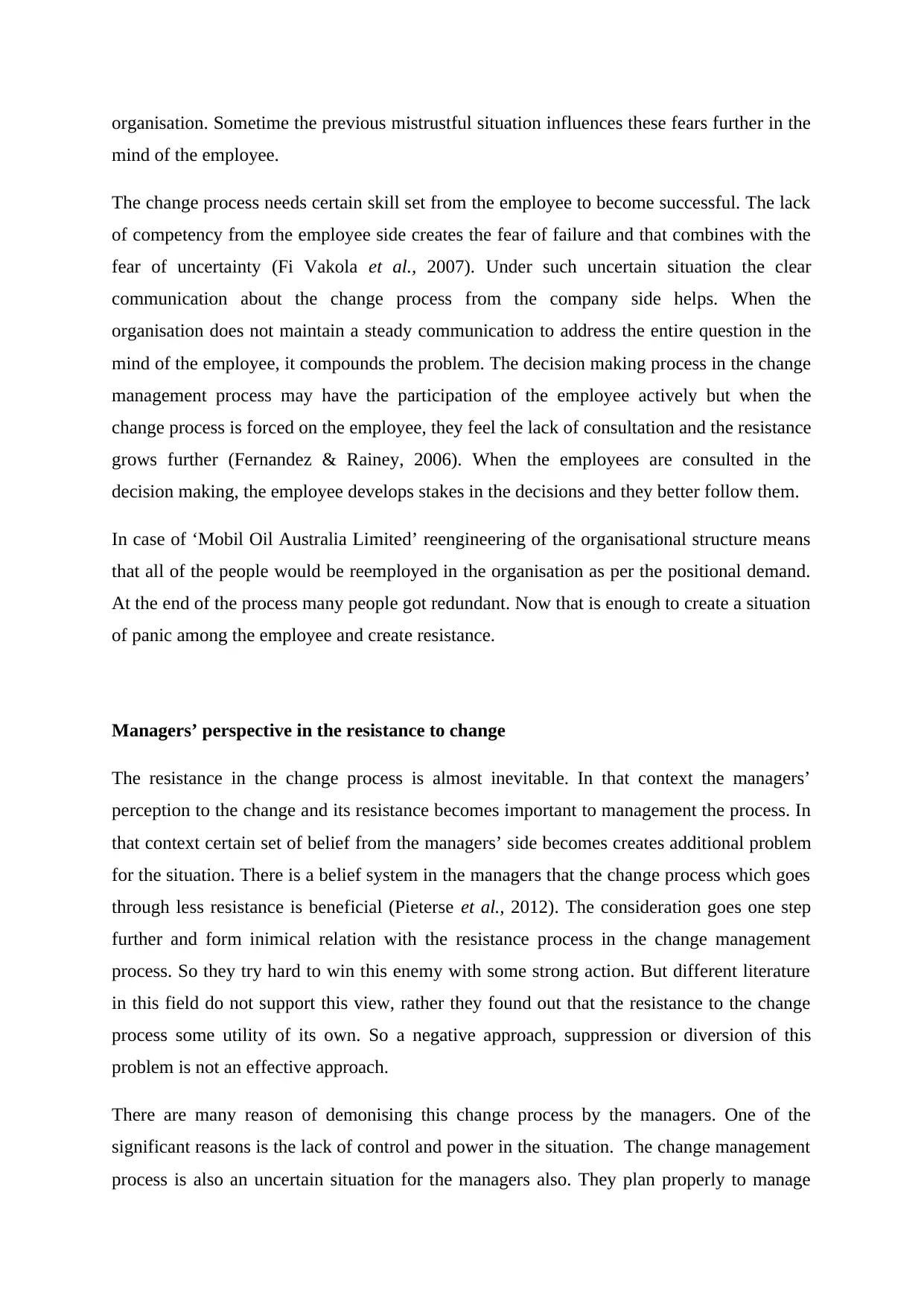
organisation. Sometime the previous mistrustful situation influences these fears further in the
mind of the employee.
The change process needs certain skill set from the employee to become successful. The lack
of competency from the employee side creates the fear of failure and that combines with the
fear of uncertainty (Fi Vakola et al., 2007). Under such uncertain situation the clear
communication about the change process from the company side helps. When the
organisation does not maintain a steady communication to address the entire question in the
mind of the employee, it compounds the problem. The decision making process in the change
management process may have the participation of the employee actively but when the
change process is forced on the employee, they feel the lack of consultation and the resistance
grows further (Fernandez & Rainey, 2006). When the employees are consulted in the
decision making, the employee develops stakes in the decisions and they better follow them.
In case of ‘Mobil Oil Australia Limited’ reengineering of the organisational structure means
that all of the people would be reemployed in the organisation as per the positional demand.
At the end of the process many people got redundant. Now that is enough to create a situation
of panic among the employee and create resistance.
Managers’ perspective in the resistance to change
The resistance in the change process is almost inevitable. In that context the managers’
perception to the change and its resistance becomes important to management the process. In
that context certain set of belief from the managers’ side becomes creates additional problem
for the situation. There is a belief system in the managers that the change process which goes
through less resistance is beneficial (Pieterse et al., 2012). The consideration goes one step
further and form inimical relation with the resistance process in the change management
process. So they try hard to win this enemy with some strong action. But different literature
in this field do not support this view, rather they found out that the resistance to the change
process some utility of its own. So a negative approach, suppression or diversion of this
problem is not an effective approach.
There are many reason of demonising this change process by the managers. One of the
significant reasons is the lack of control and power in the situation. The change management
process is also an uncertain situation for the managers also. They plan properly to manage
mind of the employee.
The change process needs certain skill set from the employee to become successful. The lack
of competency from the employee side creates the fear of failure and that combines with the
fear of uncertainty (Fi Vakola et al., 2007). Under such uncertain situation the clear
communication about the change process from the company side helps. When the
organisation does not maintain a steady communication to address the entire question in the
mind of the employee, it compounds the problem. The decision making process in the change
management process may have the participation of the employee actively but when the
change process is forced on the employee, they feel the lack of consultation and the resistance
grows further (Fernandez & Rainey, 2006). When the employees are consulted in the
decision making, the employee develops stakes in the decisions and they better follow them.
In case of ‘Mobil Oil Australia Limited’ reengineering of the organisational structure means
that all of the people would be reemployed in the organisation as per the positional demand.
At the end of the process many people got redundant. Now that is enough to create a situation
of panic among the employee and create resistance.
Managers’ perspective in the resistance to change
The resistance in the change process is almost inevitable. In that context the managers’
perception to the change and its resistance becomes important to management the process. In
that context certain set of belief from the managers’ side becomes creates additional problem
for the situation. There is a belief system in the managers that the change process which goes
through less resistance is beneficial (Pieterse et al., 2012). The consideration goes one step
further and form inimical relation with the resistance process in the change management
process. So they try hard to win this enemy with some strong action. But different literature
in this field do not support this view, rather they found out that the resistance to the change
process some utility of its own. So a negative approach, suppression or diversion of this
problem is not an effective approach.
There are many reason of demonising this change process by the managers. One of the
significant reasons is the lack of control and power in the situation. The change management
process is also an uncertain situation for the managers also. They plan properly to manage
⊘ This is a preview!⊘
Do you want full access?
Subscribe today to unlock all pages.

Trusted by 1+ million students worldwide
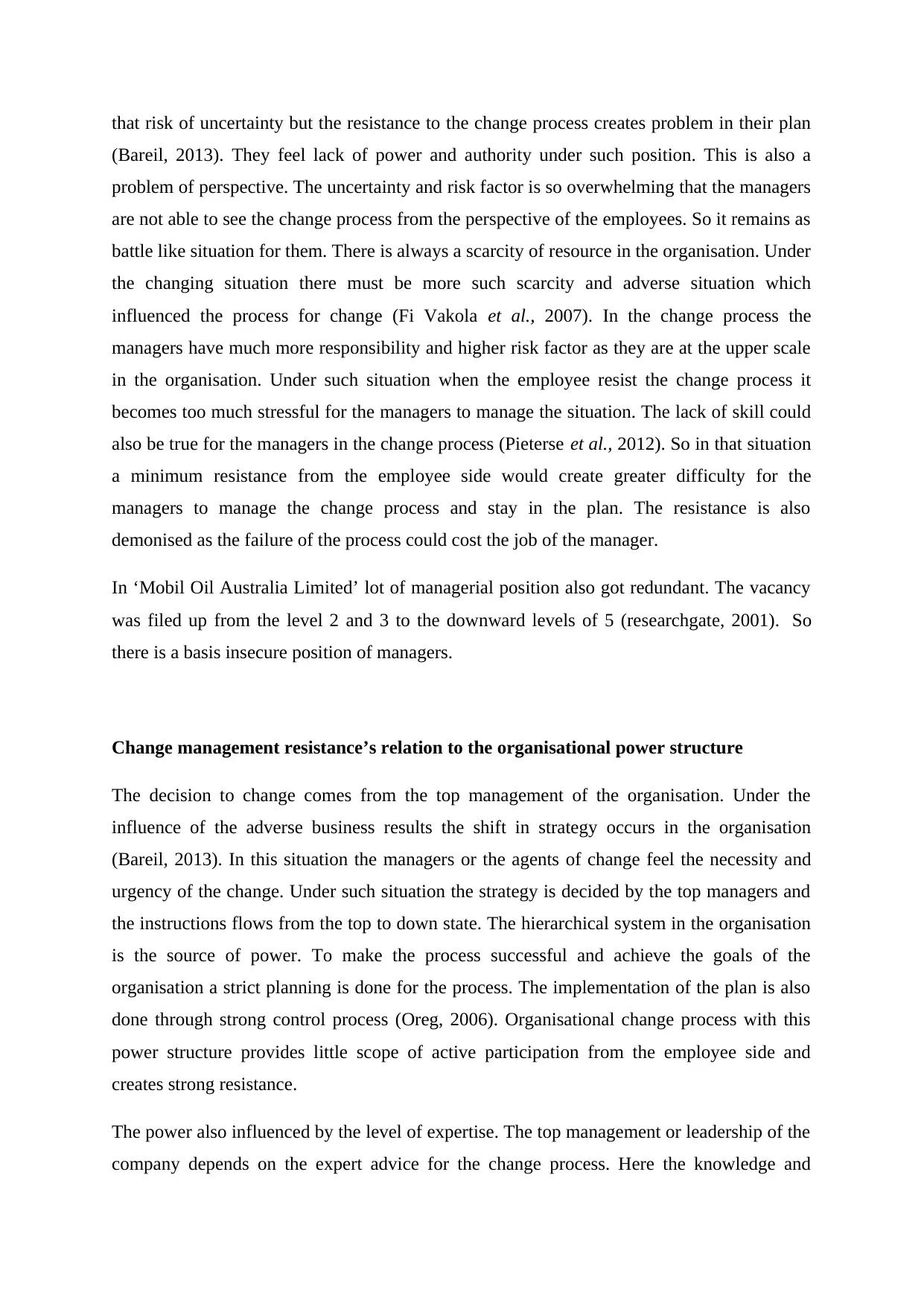
that risk of uncertainty but the resistance to the change process creates problem in their plan
(Bareil, 2013). They feel lack of power and authority under such position. This is also a
problem of perspective. The uncertainty and risk factor is so overwhelming that the managers
are not able to see the change process from the perspective of the employees. So it remains as
battle like situation for them. There is always a scarcity of resource in the organisation. Under
the changing situation there must be more such scarcity and adverse situation which
influenced the process for change (Fi Vakola et al., 2007). In the change process the
managers have much more responsibility and higher risk factor as they are at the upper scale
in the organisation. Under such situation when the employee resist the change process it
becomes too much stressful for the managers to manage the situation. The lack of skill could
also be true for the managers in the change process (Pieterse et al., 2012). So in that situation
a minimum resistance from the employee side would create greater difficulty for the
managers to manage the change process and stay in the plan. The resistance is also
demonised as the failure of the process could cost the job of the manager.
In ‘Mobil Oil Australia Limited’ lot of managerial position also got redundant. The vacancy
was filed up from the level 2 and 3 to the downward levels of 5 (researchgate, 2001). So
there is a basis insecure position of managers.
Change management resistance’s relation to the organisational power structure
The decision to change comes from the top management of the organisation. Under the
influence of the adverse business results the shift in strategy occurs in the organisation
(Bareil, 2013). In this situation the managers or the agents of change feel the necessity and
urgency of the change. Under such situation the strategy is decided by the top managers and
the instructions flows from the top to down state. The hierarchical system in the organisation
is the source of power. To make the process successful and achieve the goals of the
organisation a strict planning is done for the process. The implementation of the plan is also
done through strong control process (Oreg, 2006). Organisational change process with this
power structure provides little scope of active participation from the employee side and
creates strong resistance.
The power also influenced by the level of expertise. The top management or leadership of the
company depends on the expert advice for the change process. Here the knowledge and
(Bareil, 2013). They feel lack of power and authority under such position. This is also a
problem of perspective. The uncertainty and risk factor is so overwhelming that the managers
are not able to see the change process from the perspective of the employees. So it remains as
battle like situation for them. There is always a scarcity of resource in the organisation. Under
the changing situation there must be more such scarcity and adverse situation which
influenced the process for change (Fi Vakola et al., 2007). In the change process the
managers have much more responsibility and higher risk factor as they are at the upper scale
in the organisation. Under such situation when the employee resist the change process it
becomes too much stressful for the managers to manage the situation. The lack of skill could
also be true for the managers in the change process (Pieterse et al., 2012). So in that situation
a minimum resistance from the employee side would create greater difficulty for the
managers to manage the change process and stay in the plan. The resistance is also
demonised as the failure of the process could cost the job of the manager.
In ‘Mobil Oil Australia Limited’ lot of managerial position also got redundant. The vacancy
was filed up from the level 2 and 3 to the downward levels of 5 (researchgate, 2001). So
there is a basis insecure position of managers.
Change management resistance’s relation to the organisational power structure
The decision to change comes from the top management of the organisation. Under the
influence of the adverse business results the shift in strategy occurs in the organisation
(Bareil, 2013). In this situation the managers or the agents of change feel the necessity and
urgency of the change. Under such situation the strategy is decided by the top managers and
the instructions flows from the top to down state. The hierarchical system in the organisation
is the source of power. To make the process successful and achieve the goals of the
organisation a strict planning is done for the process. The implementation of the plan is also
done through strong control process (Oreg, 2006). Organisational change process with this
power structure provides little scope of active participation from the employee side and
creates strong resistance.
The power also influenced by the level of expertise. The top management or leadership of the
company depends on the expert advice for the change process. Here the knowledge and
Paraphrase This Document
Need a fresh take? Get an instant paraphrase of this document with our AI Paraphraser
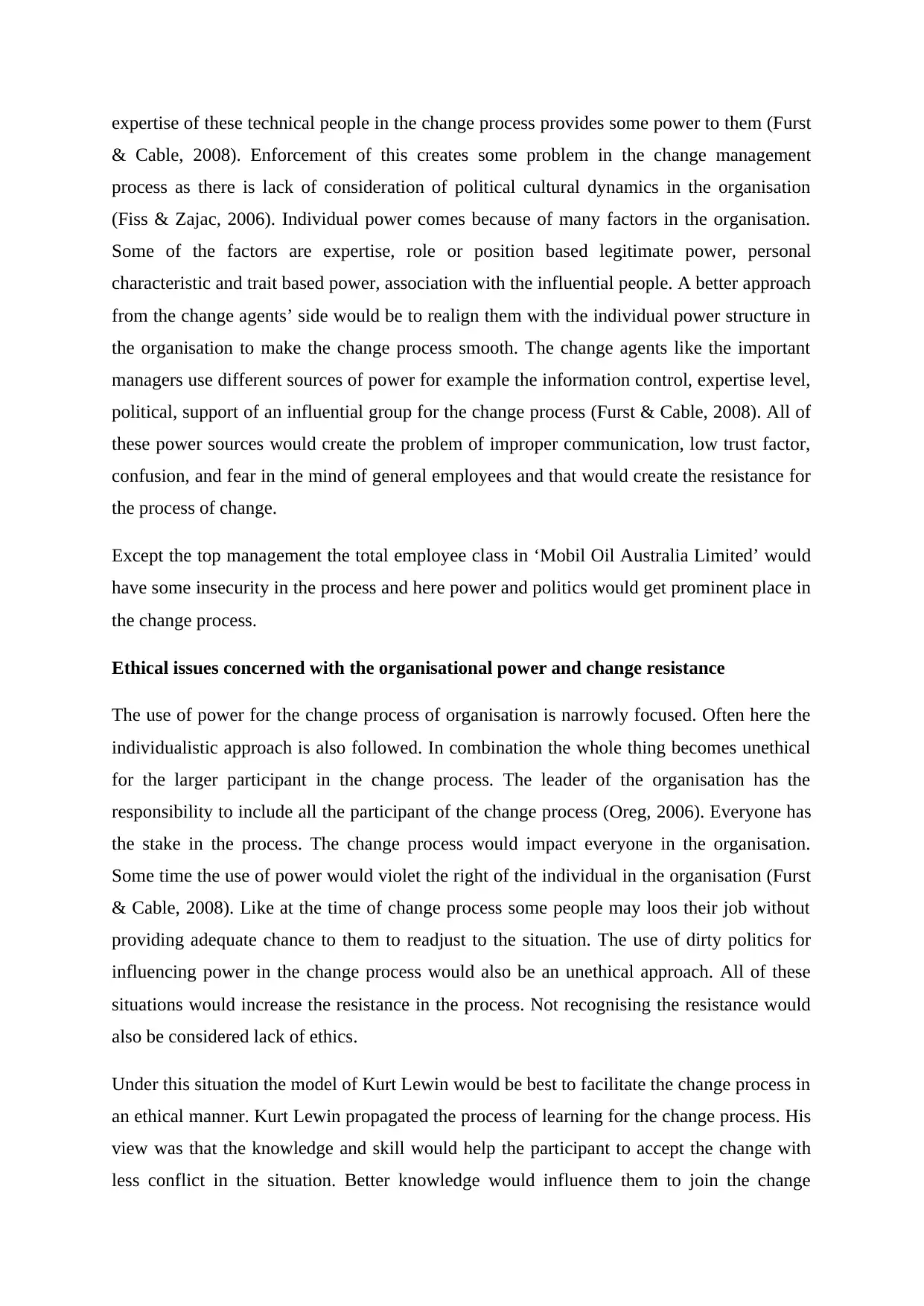
expertise of these technical people in the change process provides some power to them (Furst
& Cable, 2008). Enforcement of this creates some problem in the change management
process as there is lack of consideration of political cultural dynamics in the organisation
(Fiss & Zajac, 2006). Individual power comes because of many factors in the organisation.
Some of the factors are expertise, role or position based legitimate power, personal
characteristic and trait based power, association with the influential people. A better approach
from the change agents’ side would be to realign them with the individual power structure in
the organisation to make the change process smooth. The change agents like the important
managers use different sources of power for example the information control, expertise level,
political, support of an influential group for the change process (Furst & Cable, 2008). All of
these power sources would create the problem of improper communication, low trust factor,
confusion, and fear in the mind of general employees and that would create the resistance for
the process of change.
Except the top management the total employee class in ‘Mobil Oil Australia Limited’ would
have some insecurity in the process and here power and politics would get prominent place in
the change process.
Ethical issues concerned with the organisational power and change resistance
The use of power for the change process of organisation is narrowly focused. Often here the
individualistic approach is also followed. In combination the whole thing becomes unethical
for the larger participant in the change process. The leader of the organisation has the
responsibility to include all the participant of the change process (Oreg, 2006). Everyone has
the stake in the process. The change process would impact everyone in the organisation.
Some time the use of power would violet the right of the individual in the organisation (Furst
& Cable, 2008). Like at the time of change process some people may loos their job without
providing adequate chance to them to readjust to the situation. The use of dirty politics for
influencing power in the change process would also be an unethical approach. All of these
situations would increase the resistance in the process. Not recognising the resistance would
also be considered lack of ethics.
Under this situation the model of Kurt Lewin would be best to facilitate the change process in
an ethical manner. Kurt Lewin propagated the process of learning for the change process. His
view was that the knowledge and skill would help the participant to accept the change with
less conflict in the situation. Better knowledge would influence them to join the change
& Cable, 2008). Enforcement of this creates some problem in the change management
process as there is lack of consideration of political cultural dynamics in the organisation
(Fiss & Zajac, 2006). Individual power comes because of many factors in the organisation.
Some of the factors are expertise, role or position based legitimate power, personal
characteristic and trait based power, association with the influential people. A better approach
from the change agents’ side would be to realign them with the individual power structure in
the organisation to make the change process smooth. The change agents like the important
managers use different sources of power for example the information control, expertise level,
political, support of an influential group for the change process (Furst & Cable, 2008). All of
these power sources would create the problem of improper communication, low trust factor,
confusion, and fear in the mind of general employees and that would create the resistance for
the process of change.
Except the top management the total employee class in ‘Mobil Oil Australia Limited’ would
have some insecurity in the process and here power and politics would get prominent place in
the change process.
Ethical issues concerned with the organisational power and change resistance
The use of power for the change process of organisation is narrowly focused. Often here the
individualistic approach is also followed. In combination the whole thing becomes unethical
for the larger participant in the change process. The leader of the organisation has the
responsibility to include all the participant of the change process (Oreg, 2006). Everyone has
the stake in the process. The change process would impact everyone in the organisation.
Some time the use of power would violet the right of the individual in the organisation (Furst
& Cable, 2008). Like at the time of change process some people may loos their job without
providing adequate chance to them to readjust to the situation. The use of dirty politics for
influencing power in the change process would also be an unethical approach. All of these
situations would increase the resistance in the process. Not recognising the resistance would
also be considered lack of ethics.
Under this situation the model of Kurt Lewin would be best to facilitate the change process in
an ethical manner. Kurt Lewin propagated the process of learning for the change process. His
view was that the knowledge and skill would help the participant to accept the change with
less conflict in the situation. Better knowledge would influence them to join the change
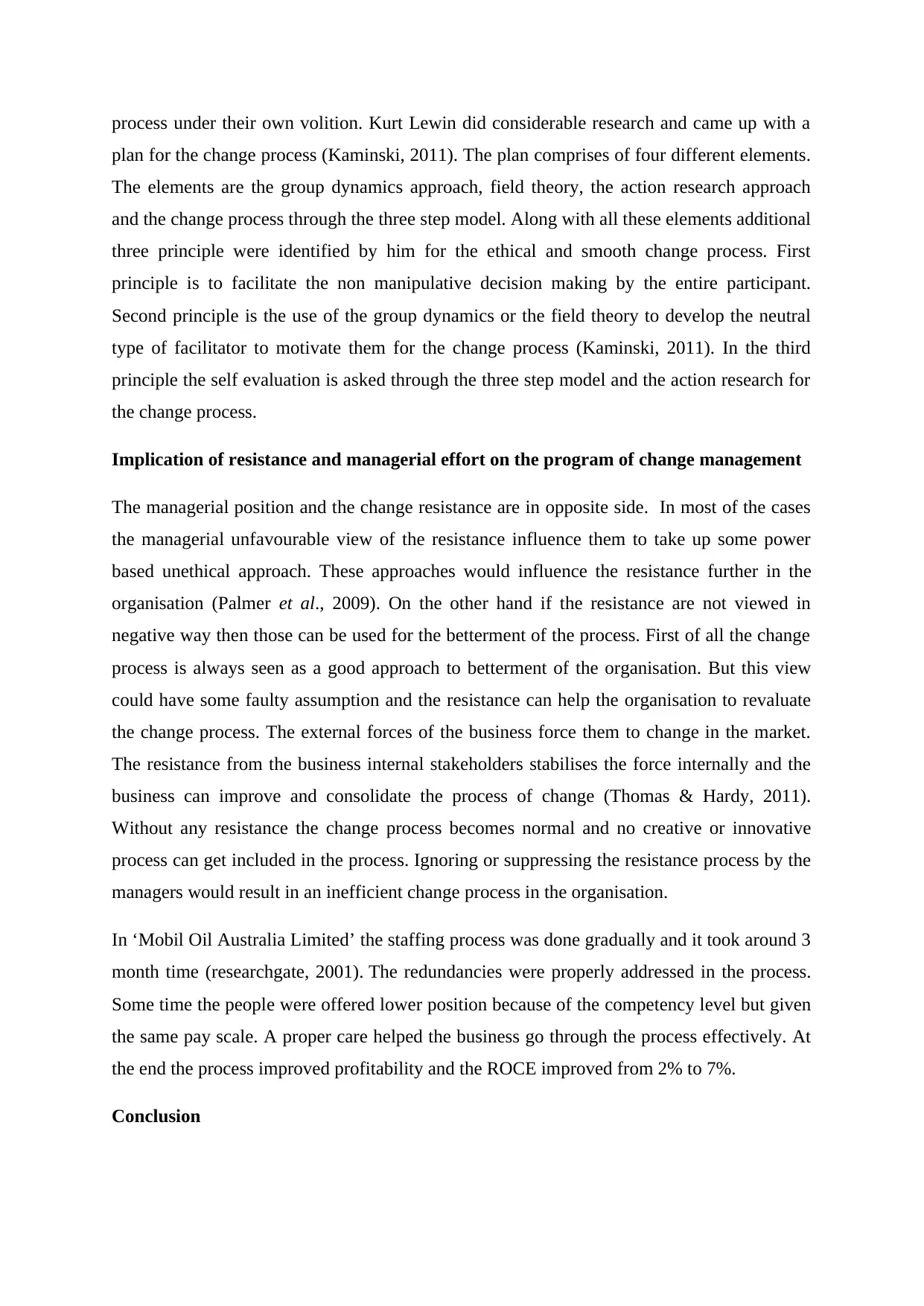
process under their own volition. Kurt Lewin did considerable research and came up with a
plan for the change process (Kaminski, 2011). The plan comprises of four different elements.
The elements are the group dynamics approach, field theory, the action research approach
and the change process through the three step model. Along with all these elements additional
three principle were identified by him for the ethical and smooth change process. First
principle is to facilitate the non manipulative decision making by the entire participant.
Second principle is the use of the group dynamics or the field theory to develop the neutral
type of facilitator to motivate them for the change process (Kaminski, 2011). In the third
principle the self evaluation is asked through the three step model and the action research for
the change process.
Implication of resistance and managerial effort on the program of change management
The managerial position and the change resistance are in opposite side. In most of the cases
the managerial unfavourable view of the resistance influence them to take up some power
based unethical approach. These approaches would influence the resistance further in the
organisation (Palmer et al., 2009). On the other hand if the resistance are not viewed in
negative way then those can be used for the betterment of the process. First of all the change
process is always seen as a good approach to betterment of the organisation. But this view
could have some faulty assumption and the resistance can help the organisation to revaluate
the change process. The external forces of the business force them to change in the market.
The resistance from the business internal stakeholders stabilises the force internally and the
business can improve and consolidate the process of change (Thomas & Hardy, 2011).
Without any resistance the change process becomes normal and no creative or innovative
process can get included in the process. Ignoring or suppressing the resistance process by the
managers would result in an inefficient change process in the organisation.
In ‘Mobil Oil Australia Limited’ the staffing process was done gradually and it took around 3
month time (researchgate, 2001). The redundancies were properly addressed in the process.
Some time the people were offered lower position because of the competency level but given
the same pay scale. A proper care helped the business go through the process effectively. At
the end the process improved profitability and the ROCE improved from 2% to 7%.
Conclusion
plan for the change process (Kaminski, 2011). The plan comprises of four different elements.
The elements are the group dynamics approach, field theory, the action research approach
and the change process through the three step model. Along with all these elements additional
three principle were identified by him for the ethical and smooth change process. First
principle is to facilitate the non manipulative decision making by the entire participant.
Second principle is the use of the group dynamics or the field theory to develop the neutral
type of facilitator to motivate them for the change process (Kaminski, 2011). In the third
principle the self evaluation is asked through the three step model and the action research for
the change process.
Implication of resistance and managerial effort on the program of change management
The managerial position and the change resistance are in opposite side. In most of the cases
the managerial unfavourable view of the resistance influence them to take up some power
based unethical approach. These approaches would influence the resistance further in the
organisation (Palmer et al., 2009). On the other hand if the resistance are not viewed in
negative way then those can be used for the betterment of the process. First of all the change
process is always seen as a good approach to betterment of the organisation. But this view
could have some faulty assumption and the resistance can help the organisation to revaluate
the change process. The external forces of the business force them to change in the market.
The resistance from the business internal stakeholders stabilises the force internally and the
business can improve and consolidate the process of change (Thomas & Hardy, 2011).
Without any resistance the change process becomes normal and no creative or innovative
process can get included in the process. Ignoring or suppressing the resistance process by the
managers would result in an inefficient change process in the organisation.
In ‘Mobil Oil Australia Limited’ the staffing process was done gradually and it took around 3
month time (researchgate, 2001). The redundancies were properly addressed in the process.
Some time the people were offered lower position because of the competency level but given
the same pay scale. A proper care helped the business go through the process effectively. At
the end the process improved profitability and the ROCE improved from 2% to 7%.
Conclusion
⊘ This is a preview!⊘
Do you want full access?
Subscribe today to unlock all pages.

Trusted by 1+ million students worldwide
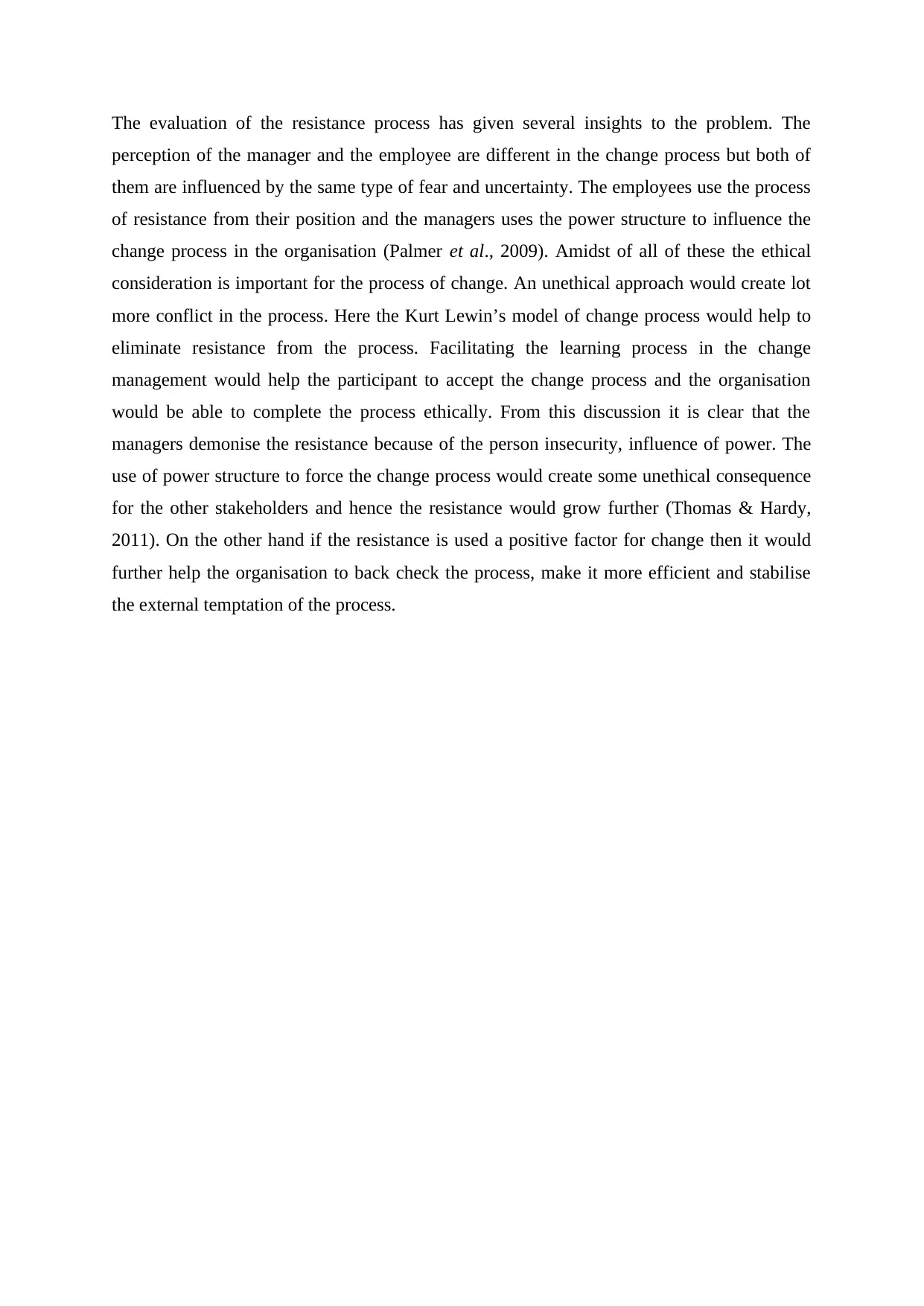
The evaluation of the resistance process has given several insights to the problem. The
perception of the manager and the employee are different in the change process but both of
them are influenced by the same type of fear and uncertainty. The employees use the process
of resistance from their position and the managers uses the power structure to influence the
change process in the organisation (Palmer et al., 2009). Amidst of all of these the ethical
consideration is important for the process of change. An unethical approach would create lot
more conflict in the process. Here the Kurt Lewin’s model of change process would help to
eliminate resistance from the process. Facilitating the learning process in the change
management would help the participant to accept the change process and the organisation
would be able to complete the process ethically. From this discussion it is clear that the
managers demonise the resistance because of the person insecurity, influence of power. The
use of power structure to force the change process would create some unethical consequence
for the other stakeholders and hence the resistance would grow further (Thomas & Hardy,
2011). On the other hand if the resistance is used a positive factor for change then it would
further help the organisation to back check the process, make it more efficient and stabilise
the external temptation of the process.
perception of the manager and the employee are different in the change process but both of
them are influenced by the same type of fear and uncertainty. The employees use the process
of resistance from their position and the managers uses the power structure to influence the
change process in the organisation (Palmer et al., 2009). Amidst of all of these the ethical
consideration is important for the process of change. An unethical approach would create lot
more conflict in the process. Here the Kurt Lewin’s model of change process would help to
eliminate resistance from the process. Facilitating the learning process in the change
management would help the participant to accept the change process and the organisation
would be able to complete the process ethically. From this discussion it is clear that the
managers demonise the resistance because of the person insecurity, influence of power. The
use of power structure to force the change process would create some unethical consequence
for the other stakeholders and hence the resistance would grow further (Thomas & Hardy,
2011). On the other hand if the resistance is used a positive factor for change then it would
further help the organisation to back check the process, make it more efficient and stabilise
the external temptation of the process.
Paraphrase This Document
Need a fresh take? Get an instant paraphrase of this document with our AI Paraphraser
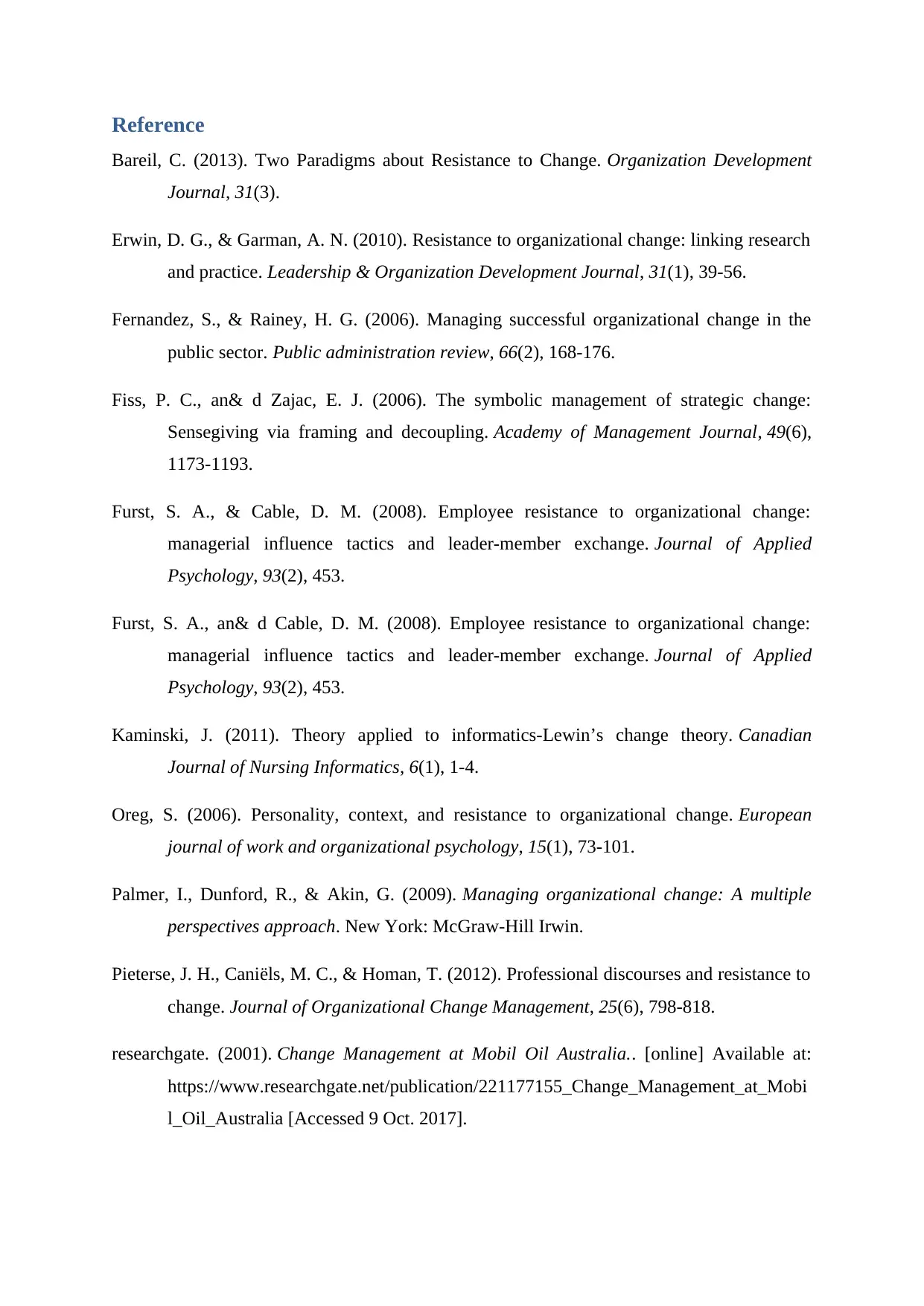
Reference
Bareil, C. (2013). Two Paradigms about Resistance to Change. Organization Development
Journal, 31(3).
Erwin, D. G., & Garman, A. N. (2010). Resistance to organizational change: linking research
and practice. Leadership & Organization Development Journal, 31(1), 39-56.
Fernandez, S., & Rainey, H. G. (2006). Managing successful organizational change in the
public sector. Public administration review, 66(2), 168-176.
Fiss, P. C., an& d Zajac, E. J. (2006). The symbolic management of strategic change:
Sensegiving via framing and decoupling. Academy of Management Journal, 49(6),
1173-1193.
Furst, S. A., & Cable, D. M. (2008). Employee resistance to organizational change:
managerial influence tactics and leader-member exchange. Journal of Applied
Psychology, 93(2), 453.
Furst, S. A., an& d Cable, D. M. (2008). Employee resistance to organizational change:
managerial influence tactics and leader-member exchange. Journal of Applied
Psychology, 93(2), 453.
Kaminski, J. (2011). Theory applied to informatics-Lewin’s change theory. Canadian
Journal of Nursing Informatics, 6(1), 1-4.
Oreg, S. (2006). Personality, context, and resistance to organizational change. European
journal of work and organizational psychology, 15(1), 73-101.
Palmer, I., Dunford, R., & Akin, G. (2009). Managing organizational change: A multiple
perspectives approach. New York: McGraw-Hill Irwin.
Pieterse, J. H., Caniëls, M. C., & Homan, T. (2012). Professional discourses and resistance to
change. Journal of Organizational Change Management, 25(6), 798-818.
researchgate. (2001). Change Management at Mobil Oil Australia.. [online] Available at:
https://www.researchgate.net/publication/221177155_Change_Management_at_Mobi
l_Oil_Australia [Accessed 9 Oct. 2017].
Bareil, C. (2013). Two Paradigms about Resistance to Change. Organization Development
Journal, 31(3).
Erwin, D. G., & Garman, A. N. (2010). Resistance to organizational change: linking research
and practice. Leadership & Organization Development Journal, 31(1), 39-56.
Fernandez, S., & Rainey, H. G. (2006). Managing successful organizational change in the
public sector. Public administration review, 66(2), 168-176.
Fiss, P. C., an& d Zajac, E. J. (2006). The symbolic management of strategic change:
Sensegiving via framing and decoupling. Academy of Management Journal, 49(6),
1173-1193.
Furst, S. A., & Cable, D. M. (2008). Employee resistance to organizational change:
managerial influence tactics and leader-member exchange. Journal of Applied
Psychology, 93(2), 453.
Furst, S. A., an& d Cable, D. M. (2008). Employee resistance to organizational change:
managerial influence tactics and leader-member exchange. Journal of Applied
Psychology, 93(2), 453.
Kaminski, J. (2011). Theory applied to informatics-Lewin’s change theory. Canadian
Journal of Nursing Informatics, 6(1), 1-4.
Oreg, S. (2006). Personality, context, and resistance to organizational change. European
journal of work and organizational psychology, 15(1), 73-101.
Palmer, I., Dunford, R., & Akin, G. (2009). Managing organizational change: A multiple
perspectives approach. New York: McGraw-Hill Irwin.
Pieterse, J. H., Caniëls, M. C., & Homan, T. (2012). Professional discourses and resistance to
change. Journal of Organizational Change Management, 25(6), 798-818.
researchgate. (2001). Change Management at Mobil Oil Australia.. [online] Available at:
https://www.researchgate.net/publication/221177155_Change_Management_at_Mobi
l_Oil_Australia [Accessed 9 Oct. 2017].

Thomas, R., & Hardy, C. (2011). Reframing resistance to organizational
change. Scandinavian Journal of Management, 27(3), 322-331.
Vakola, M., Eric Soderquist, K., and Prastacos, G. P. (2007). Competency management in
support of organisational change. International Journal of Manpower, 28(3/4), 260
change. Scandinavian Journal of Management, 27(3), 322-331.
Vakola, M., Eric Soderquist, K., and Prastacos, G. P. (2007). Competency management in
support of organisational change. International Journal of Manpower, 28(3/4), 260
⊘ This is a preview!⊘
Do you want full access?
Subscribe today to unlock all pages.

Trusted by 1+ million students worldwide
1 out of 9
Related Documents
Your All-in-One AI-Powered Toolkit for Academic Success.
+13062052269
info@desklib.com
Available 24*7 on WhatsApp / Email
![[object Object]](/_next/static/media/star-bottom.7253800d.svg)
Unlock your academic potential
Copyright © 2020–2025 A2Z Services. All Rights Reserved. Developed and managed by ZUCOL.





